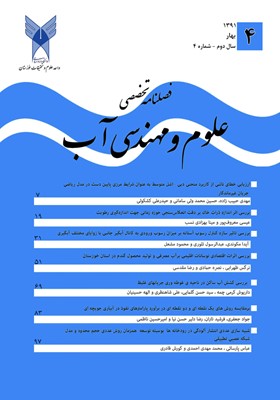Evaluation of Error Due to Applying Average Rating Curve as downstream Boundary Condition in Unsteady Flow Modeling
الموضوعات :مهدی حبیب زاده 1 , حسین محمد ولی سامانی 2 , حیدرعلی کشکولی 3
1 - دانشگاه آزاد اسلامی، واحد علوم و تحقیقات خوزستان، گروه سازه آبی، اهواز، ایران
2 - دانشگاه آزاد اسلامی واحد علوم و تحقیقات خوزستان، گروه سازههای آبی، اهواز، ایران.
3 - دانشگاه آزاد اسلامی واحد علوم و تحقیقات خوزستان، گروه سازههای آبی، اهواز، ایران.
الکلمات المفتاحية: Mathematical Modeling, Rating Curve, Unsteady Flow, Downstream Boundary Condition, HECRAS, منحنی دبی - اشل, جریان غیرماندگار, مدل ریاضی هیدرولیکی, شرایط مرزی پایین دست. HEC-RAS, Loop Rating Curve,
ملخص المقالة :
The rating curve is the relationship between the water stage and the associated discharge in a givensection of a channel. In steady flow, this relationship usually has exponential type, whereas inunsteady it flow has a looped shape. Since direct developing of actual looped rating curve by usinghydrometric methods is merely possible, steady-state rating curve is commonly used as a downstreamboundary condition in mathematical modeling of unsteady flow which leads to relevant error in modelresults. In this study, in order to evaluate this error, a method is presented by using the HEC-RASmodel of unsteady flow in a prismatic channel with different bed slopes, roughness coefficients andchannel lengths as effective parameters. In various channel geometries , the rating curves of both theapproximate and the reference states are obtained. Then statistical comparison between the results wasdone. Accordingly, 120 R-squared (R2) values refer to 240 different channel conditions, wereconsidered and the errors were analyzed which indicate that the error is declined by increasing bedslope and channel length, in addition by roughness reduction. The maximum rate of the error occurredby any of effective parameters including bed slope, roughness coefficient and channel length wasevaluated in order of appearance; 0.2617, 0.1507 and 0.1673. In addition, the sensitivity of all theparameters in different modeling conditions may be distinguished by using the obtained graphs.
امیرجانی، ر.( 1386). بررسی اثرات آب برگشتی در رودخانههای سه شاخه ای به منظور اصلاح و تعیین دبی - اشل در ایستگاههای هیدرومتری. پایان نامه کارشناسی ارشد، گروه سازههای آبی دانشگاه آزاد اسلامی واحد علوم و تحقیقات خوزستان.ص78-82.
مغربی، م. ف و حیدر بیگی، ع، الف. (1388). بررسی تحلیلی روابط دبی ـ اشل در کانالهای مرکب با زبریهای غیر یکنواخت. نشریه مهندسی عمران دانشگاه فردوسی مشهد، سال بیست و یکم، شماره یک.ص23-27.
نجمایی، م. )1369). هیدرولوژی مهندسی. چاپ دوم. انتشارات دانشگاه علم و صنعت ایران.تهران.ص45-76.
Baldassarre, Di. and Montanari, G. A. (2009). Uncertainty in river discharge observations: a quantitative analysis, Hydrol. Earth Syst. Sci. Discuss., 6, pp: 39–61.
Chow, V. T. (1958). Open Channel Hydraulics, Mc Graw Hill, Tokio, Japan, pp680
Domeneghetti, A., Castellarin, A. and Brath, A. (2010). Effects of Rating-Curve Uncertainty on The Calibration of Numerical Hydraulic Models, First IAHR European Congress, Edinburgo, Maggio, May pp: 4-6.
Dottori, F. and Martina, M. L. V. and Todini, E. (2009). A dynamic rating curve approach to indirect discharge measurement, Hydrol. Earth Syst. Sci. Discuss., 6, pp :859–896.
Henderson, F. M. (1966). Open channel flow. New York, USA: Macmilliam Series in Civil Engineering, Macmilliam eds.,pp 522.
Horritt, M. S. and Bates, P. D. )2002(. Evaluation of 1-D and 2-D models for predicting river flood inundation. J. Hydrol., 268, pp: 87–99.
Jones, B. E. (1915). A method of correcting river discharge for a changing stage, U.S. Geological Survey Water Supply Paper, 375-E, pp: 117– 130.
Shrestha, R. R. and Simonovic, S. P. (2009). A Fuzzy Set Theory Based Methodology for Analysis of Uncertainties in Stage-Discharge Measurements and Rating Curve.


